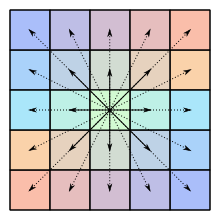
Summary
In mathematics, especially in linear algebra and matrix theory, a centrosymmetric matrix is a matrix which is symmetric about its center.

Formal definition edit
An n × n matrix A = [Ai, j] is centrosymmetric when its entries satisfy
Alternatively, if J denotes the n × n exchange matrix with 1 on the antidiagonal and 0 elsewhere:
Examples edit
Algebraic structure and properties edit
- If A and B are n × n centrosymmetric matrices over a field F, then so are A + B and cA for any c in F. Moreover, the matrix product AB is centrosymmetric, since JAB = AJB = ABJ. Since the identity matrix is also centrosymmetric, it follows that the set of n × n centrosymmetric matrices over F forms a subalgebra of the associative algebra of all n × n matrices.
- If A is a centrosymmetric matrix with an m-dimensional eigenbasis, then its m eigenvectors can each be chosen so that they satisfy either x = J x or x = − J x where J is the exchange matrix.
- If A is a centrosymmetric matrix with distinct eigenvalues, then the matrices that commute with A must be centrosymmetric.[1]
- The maximum number of unique elements in an m × m centrosymmetric matrix is
Related structures edit
An n × n matrix A is said to be skew-centrosymmetric if its entries satisfy
The centrosymmetric relation AJ = JA lends itself to a natural generalization, where J is replaced with an involutory matrix K (i.e., K2 = I )[2][3][4] or, more generally, a matrix K satisfying Km = I for an integer m > 1.[1] The inverse problem for the commutation relation AK = KA of identifying all involutory K that commute with a fixed matrix A has also been studied.[1]
Symmetric centrosymmetric matrices are sometimes called bisymmetric matrices. When the ground field is the real numbers, it has been shown that bisymmetric matrices are precisely those symmetric matrices whose eigenvalues remain the same aside from possible sign changes following pre- or post-multiplication by the exchange matrix.[3] A similar result holds for Hermitian centrosymmetric and skew-centrosymmetric matrices.[5]
References edit
- ^ a b c Yasuda, Mark (2012). "Some properties of commuting and anti-commuting m-involutions". Acta Mathematica Scientia. 32 (2): 631–644. doi:10.1016/S0252-9602(12)60044-7.
- ^ Andrew, Alan (1973). "Eigenvectors of certain matrices". Linear Algebra Appl. 7 (2): 151–162. doi:10.1016/0024-3795(73)90049-9.
- ^ a b Tao, David; Yasuda, Mark (2002). "A spectral characterization of generalized real symmetric centrosymmetric and generalized real symmetric skew-centrosymmetric matrices". SIAM J. Matrix Anal. Appl. 23 (3): 885–895. doi:10.1137/S0895479801386730.
- ^ Trench, W. F. (2004). "Characterization and properties of matrices with generalized symmetry or skew symmetry". Linear Algebra Appl. 377: 207–218. doi:10.1016/j.laa.2003.07.013.
- ^ Yasuda, Mark (2003). "A Spectral Characterization of Hermitian Centrosymmetric and Hermitian Skew-Centrosymmetric K-Matrices". SIAM J. Matrix Anal. Appl. 25 (3): 601–605. doi:10.1137/S0895479802418835.
Further reading edit
- Muir, Thomas (1960). A Treatise on the Theory of Determinants. Dover. p. 19. ISBN 0-486-60670-8.
- Weaver, James R. (1985). "Centrosymmetric (cross-symmetric) matrices, their basic properties, eigenvalues, and eigenvectors". American Mathematical Monthly. 92 (10): 711–717. doi:10.2307/2323222. JSTOR 2323222.
External links edit
- Centrosymmetric matrix on MathWorld.


